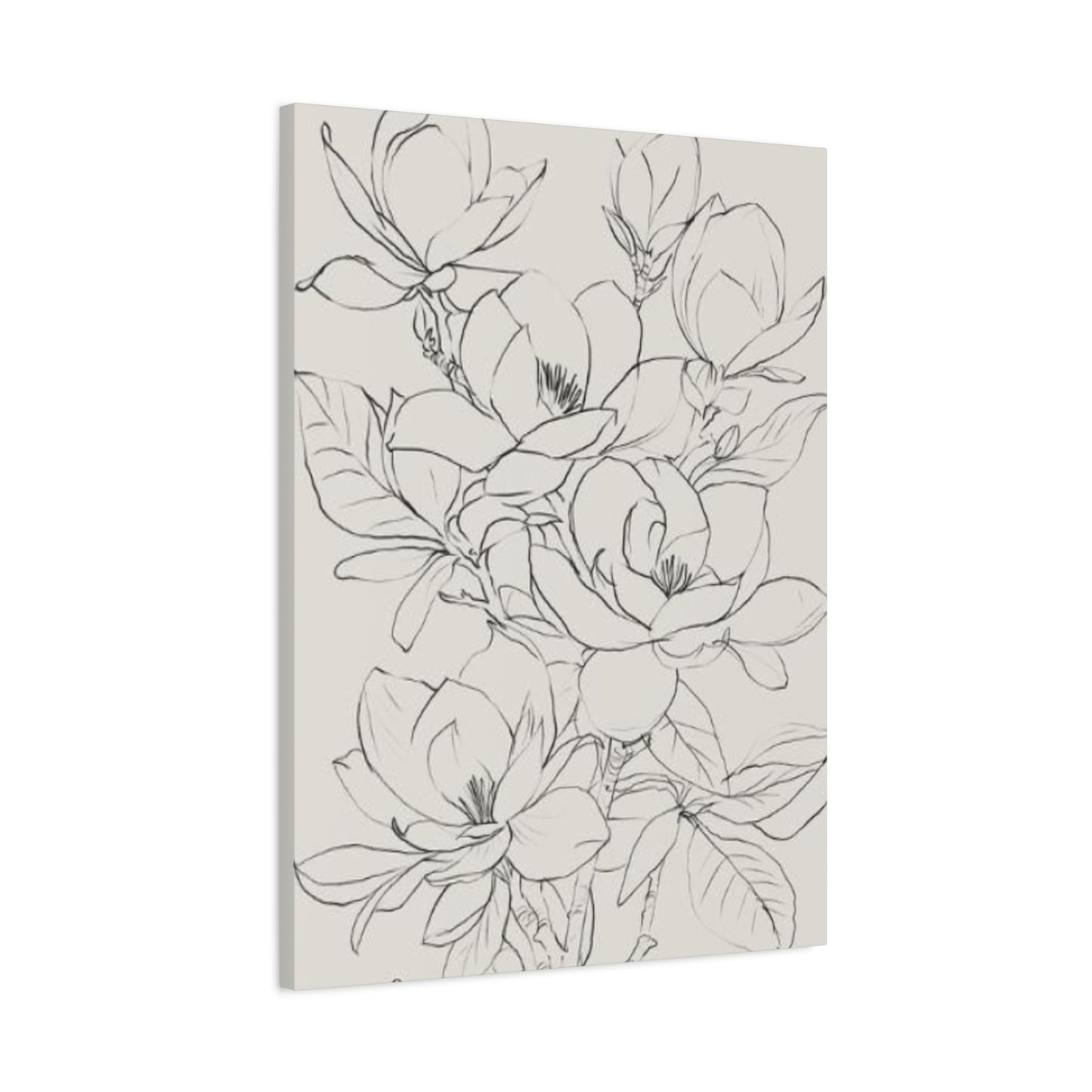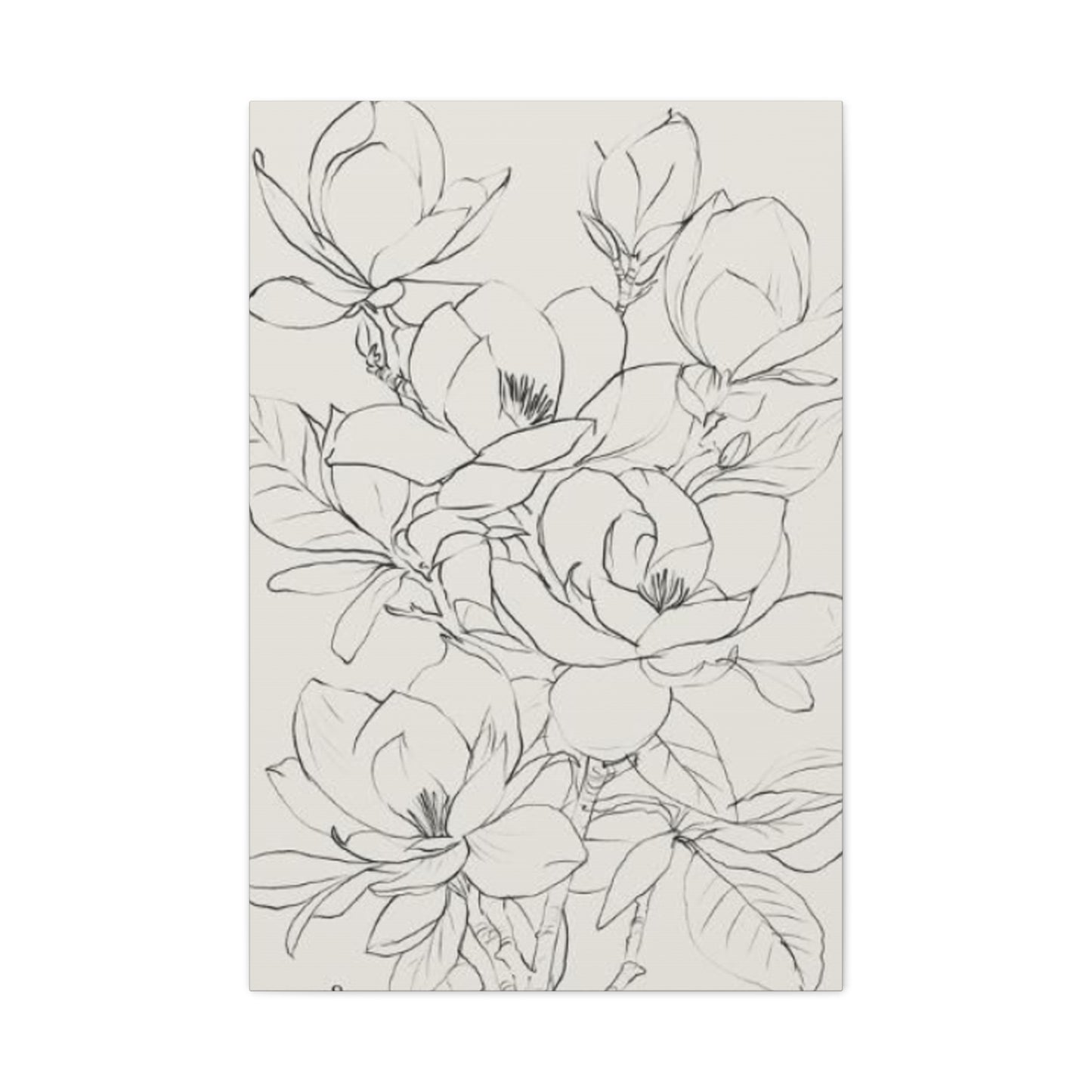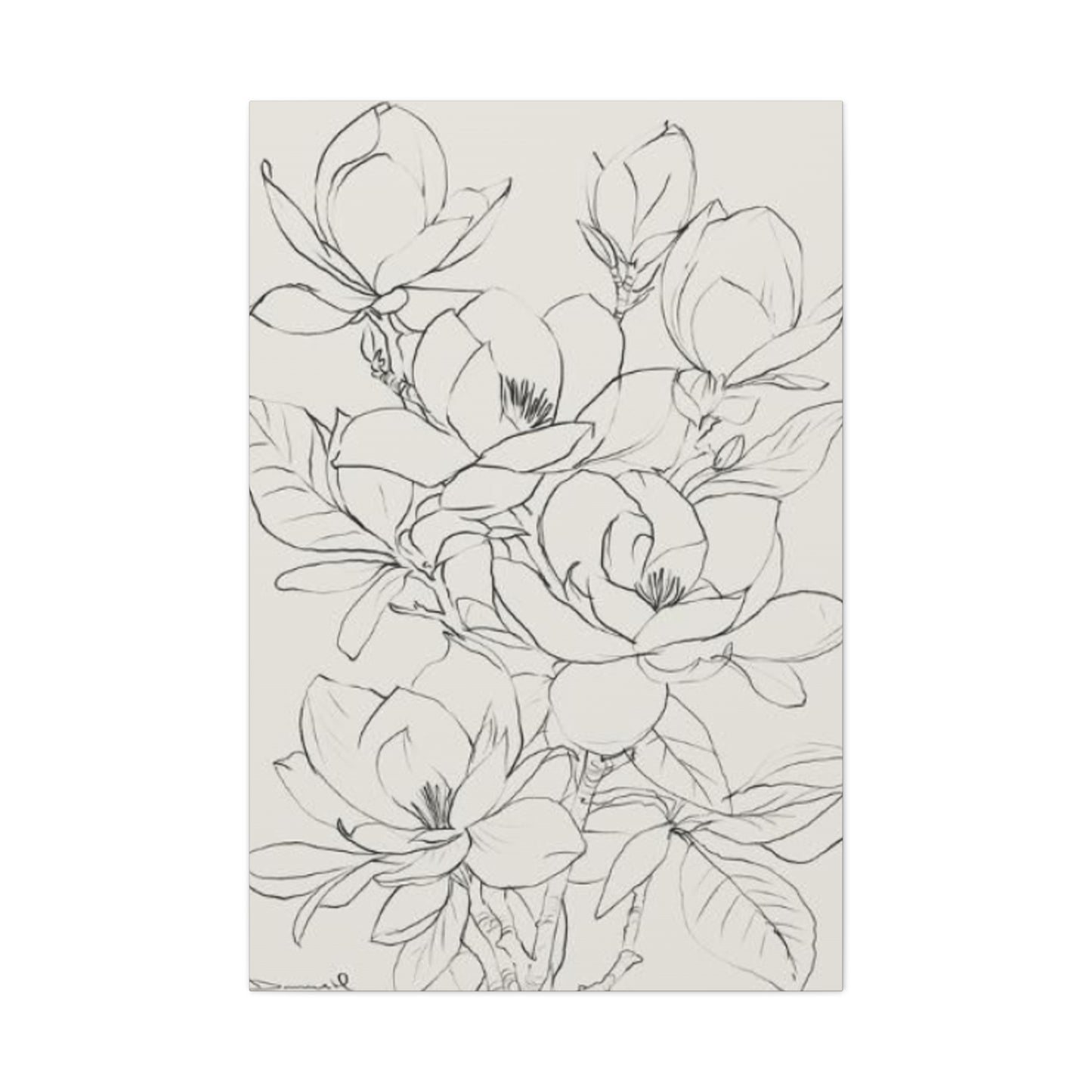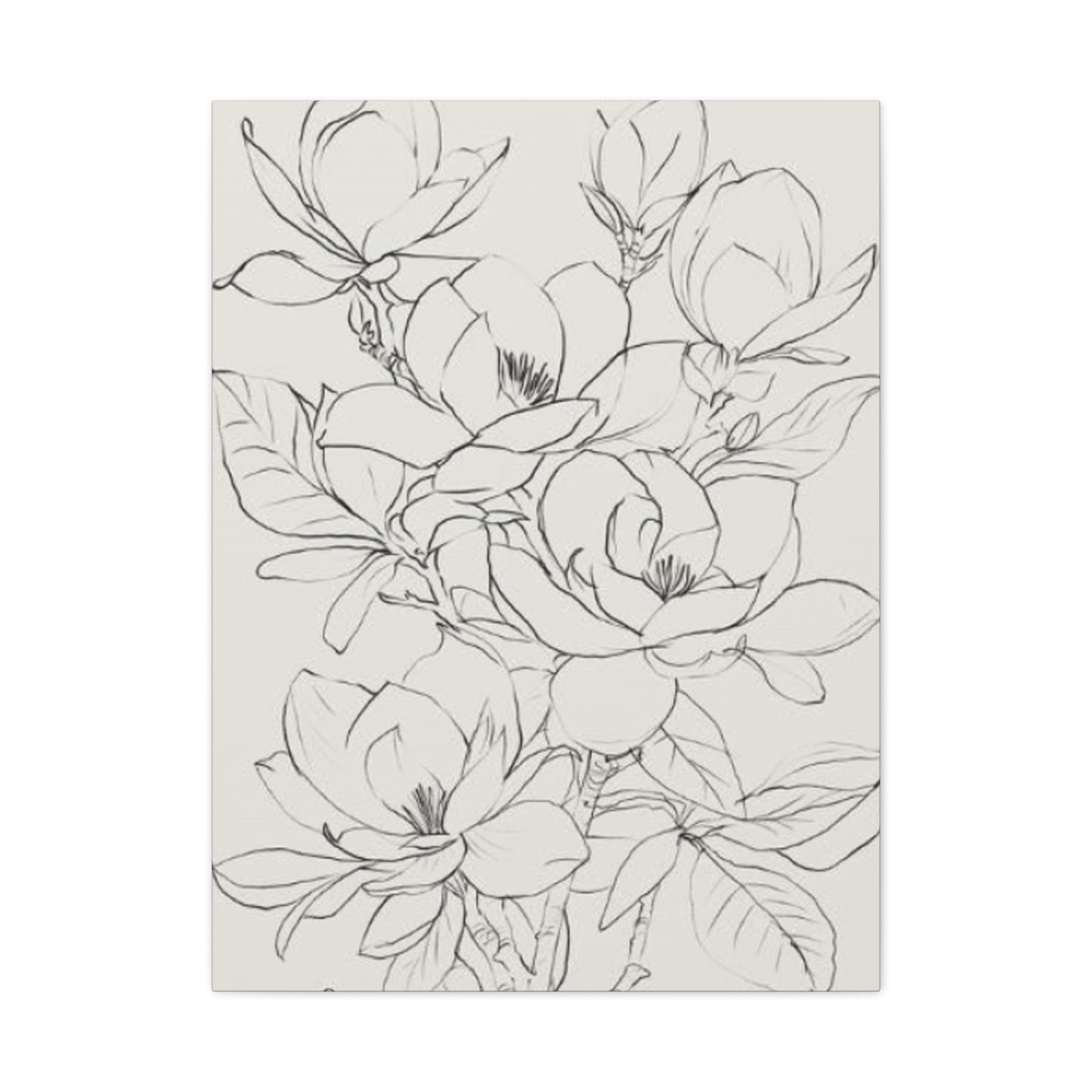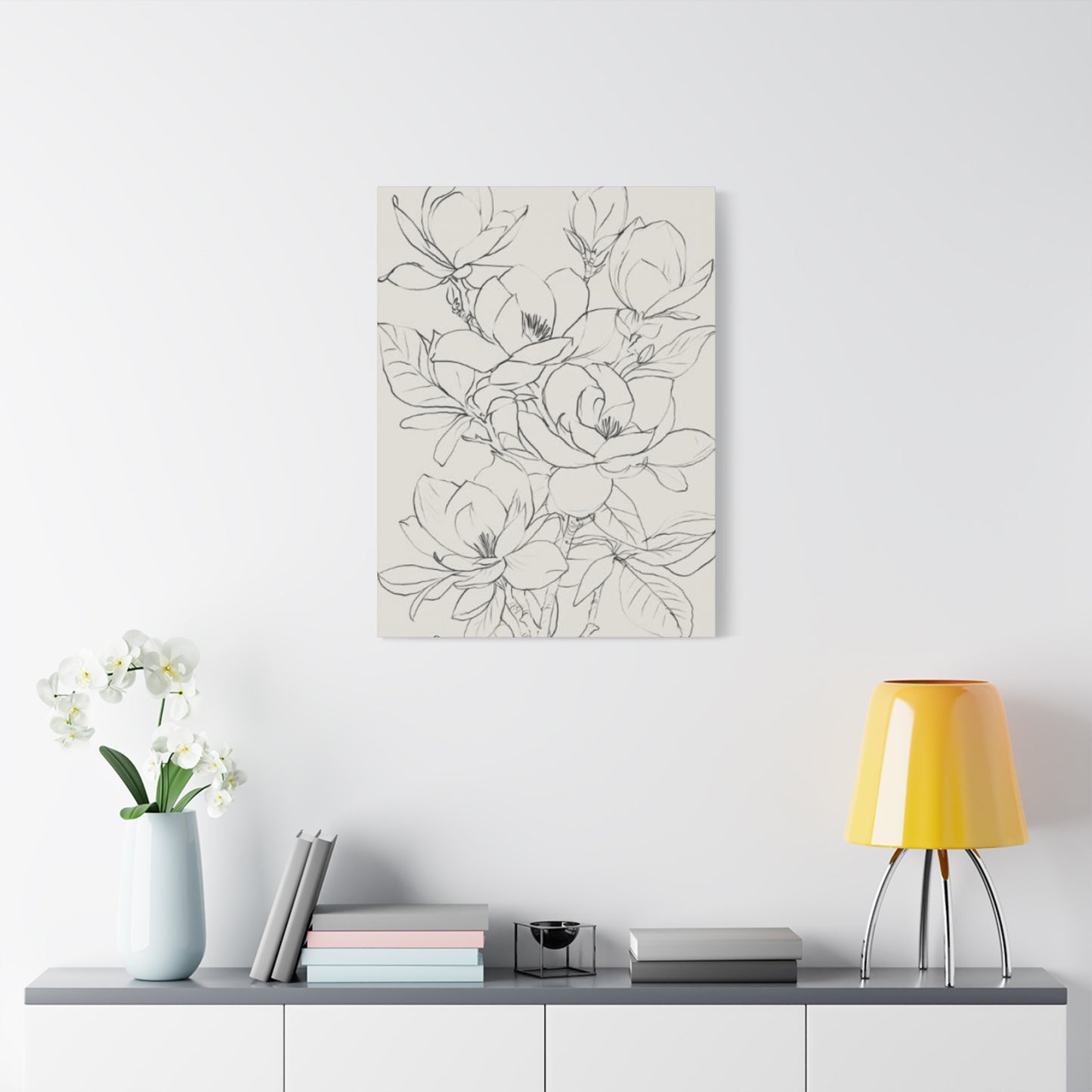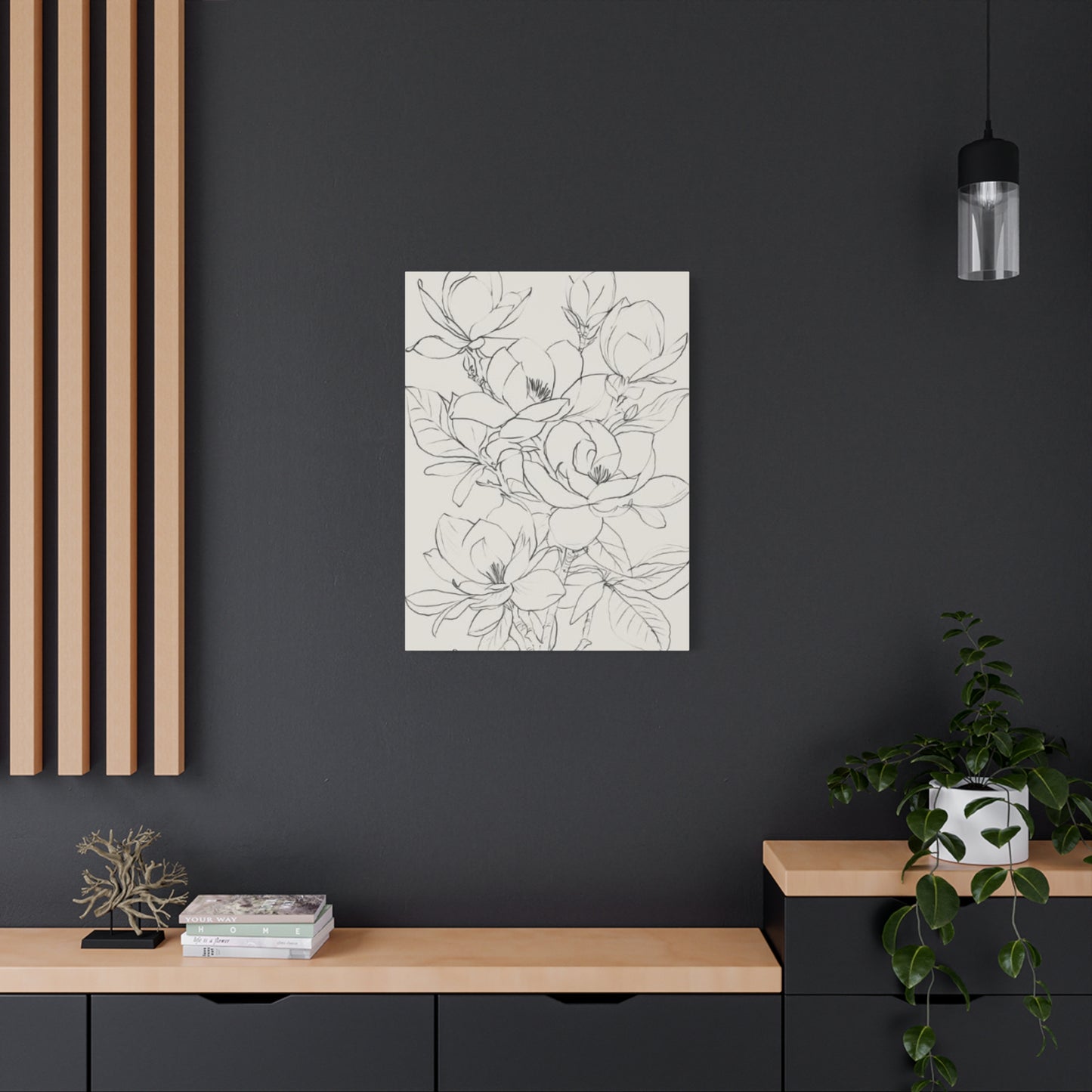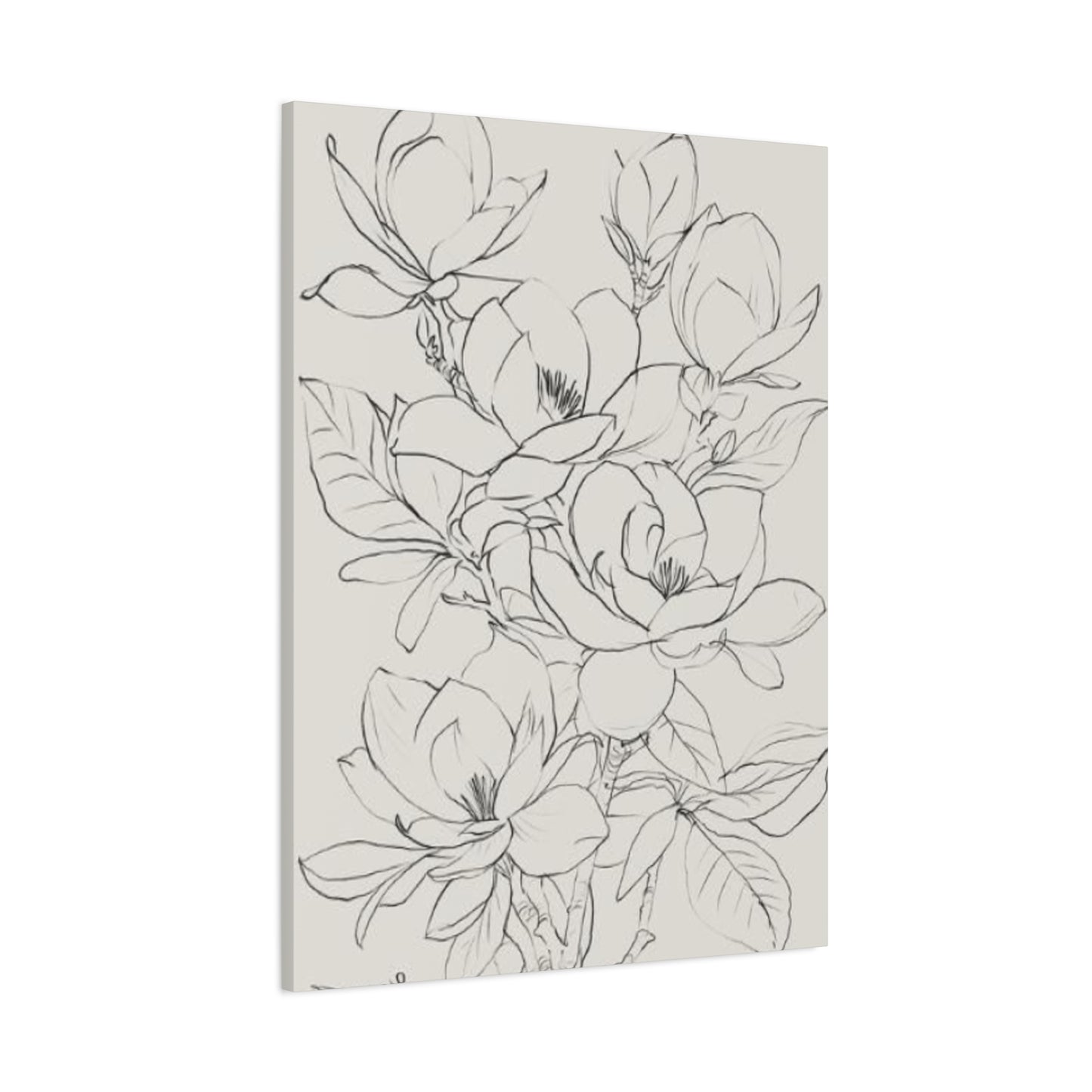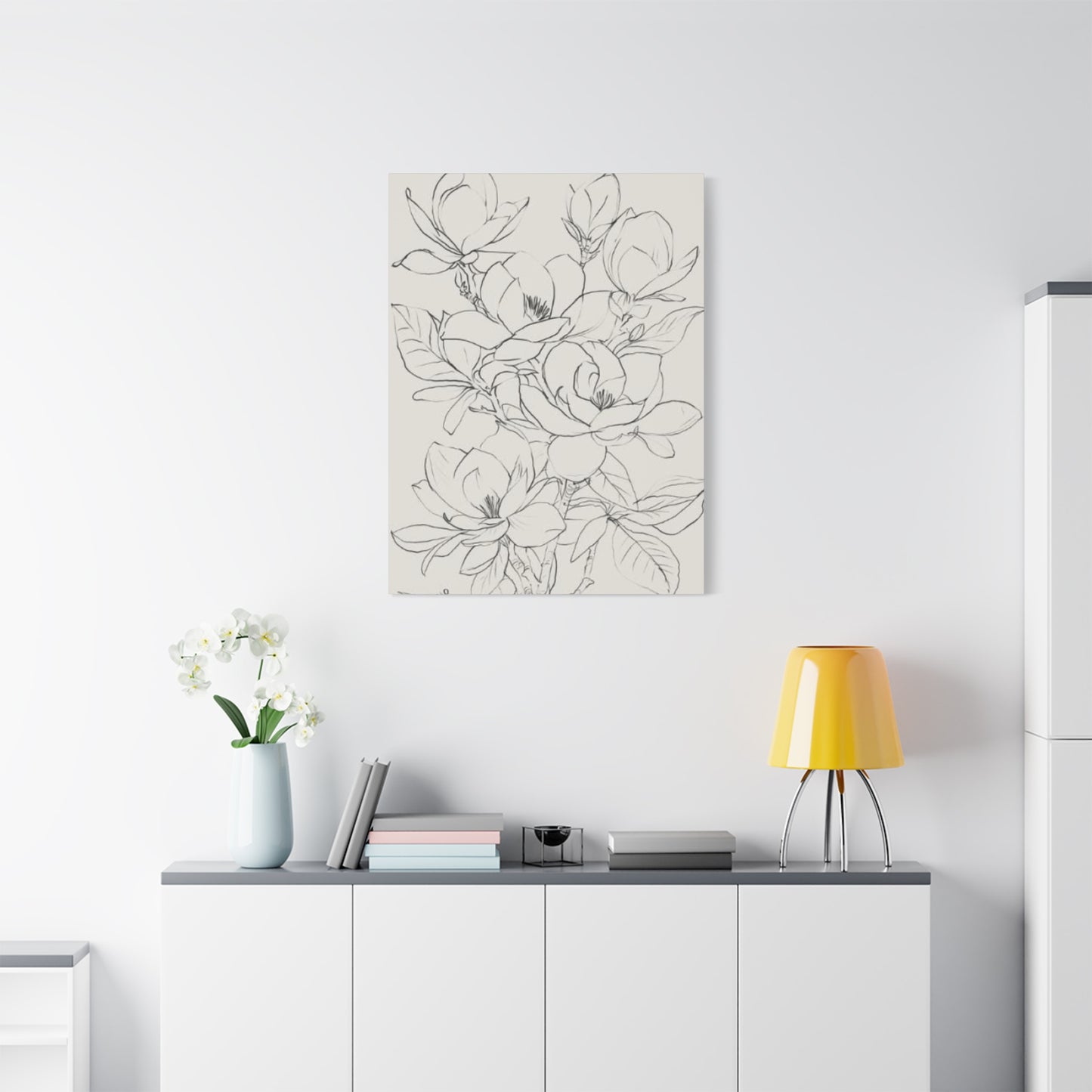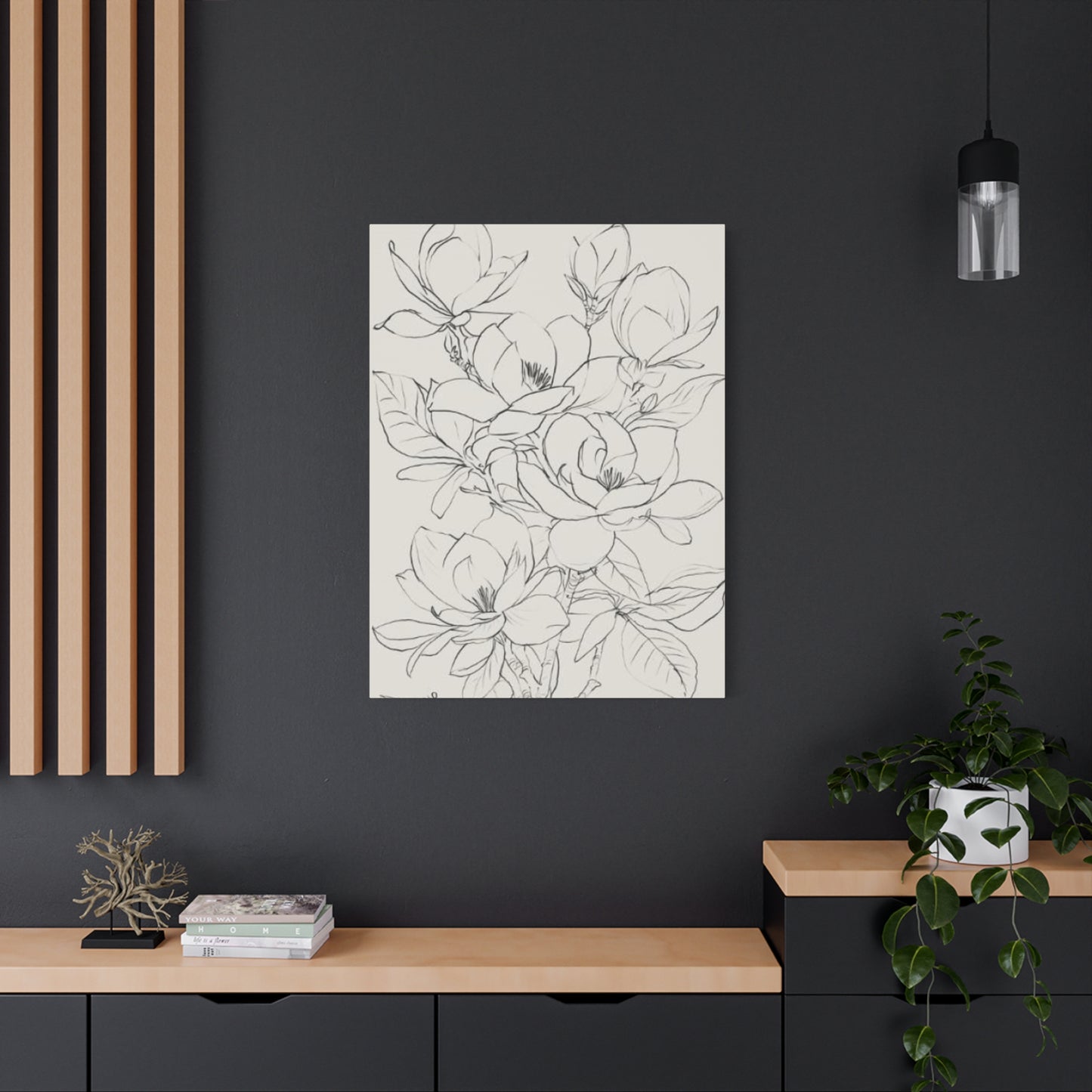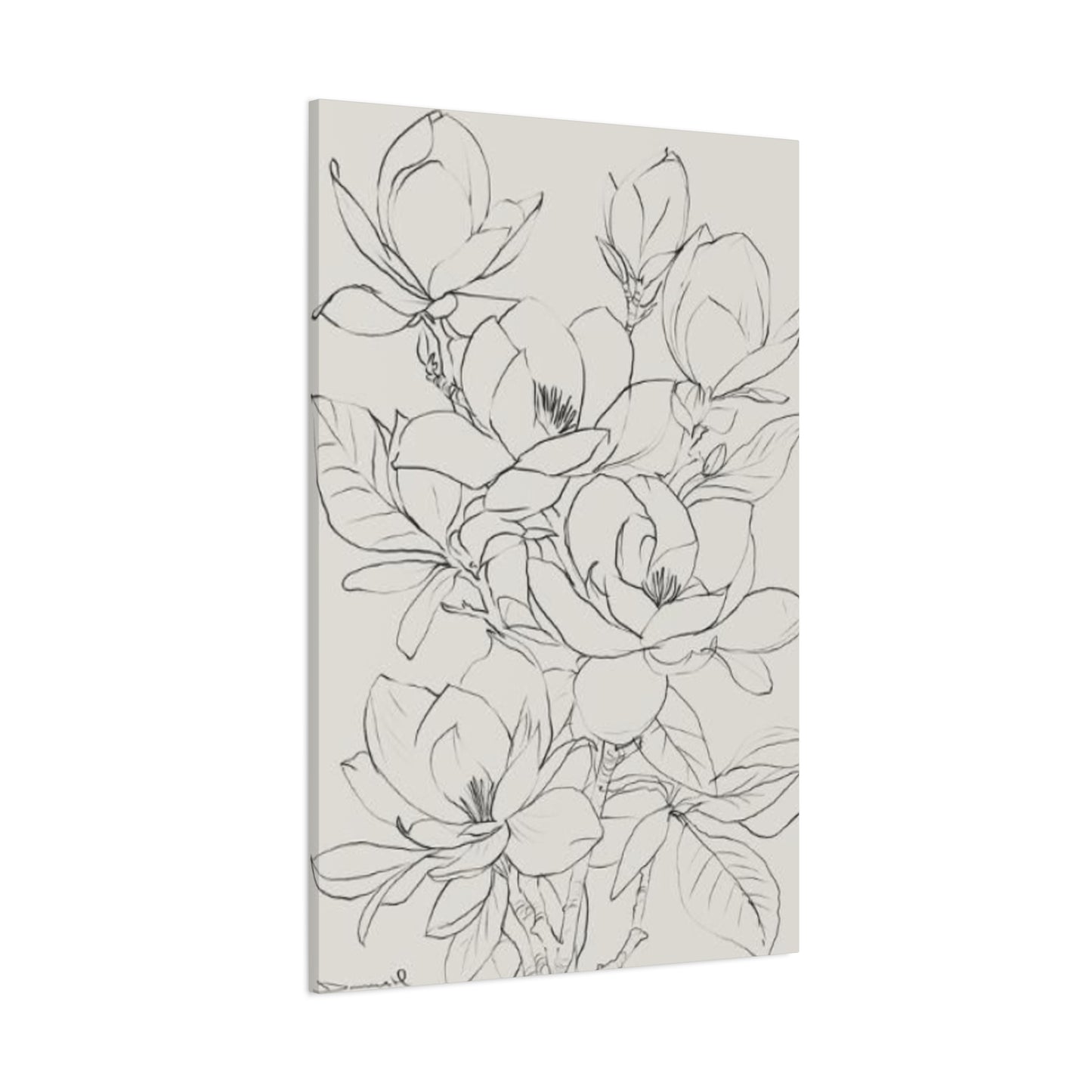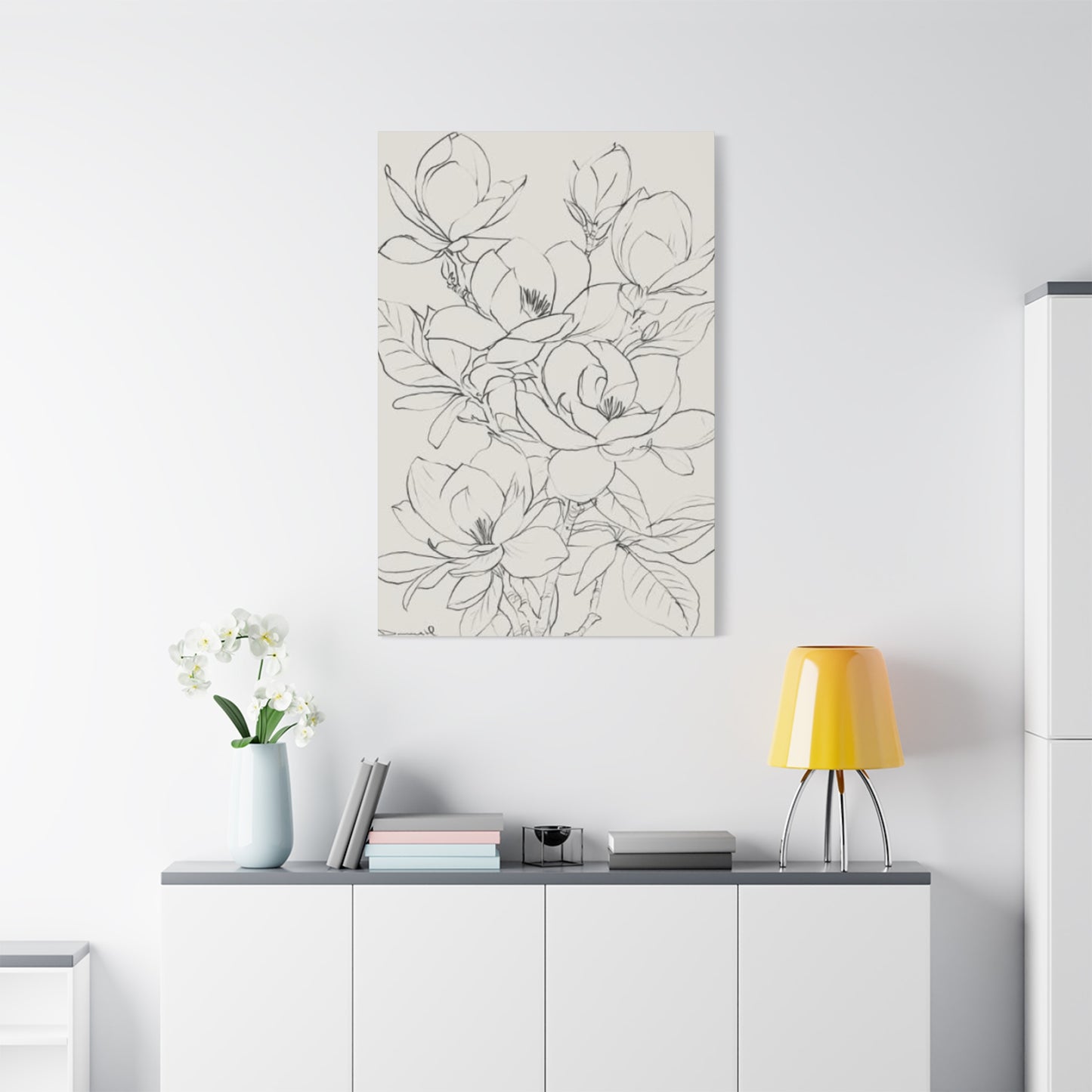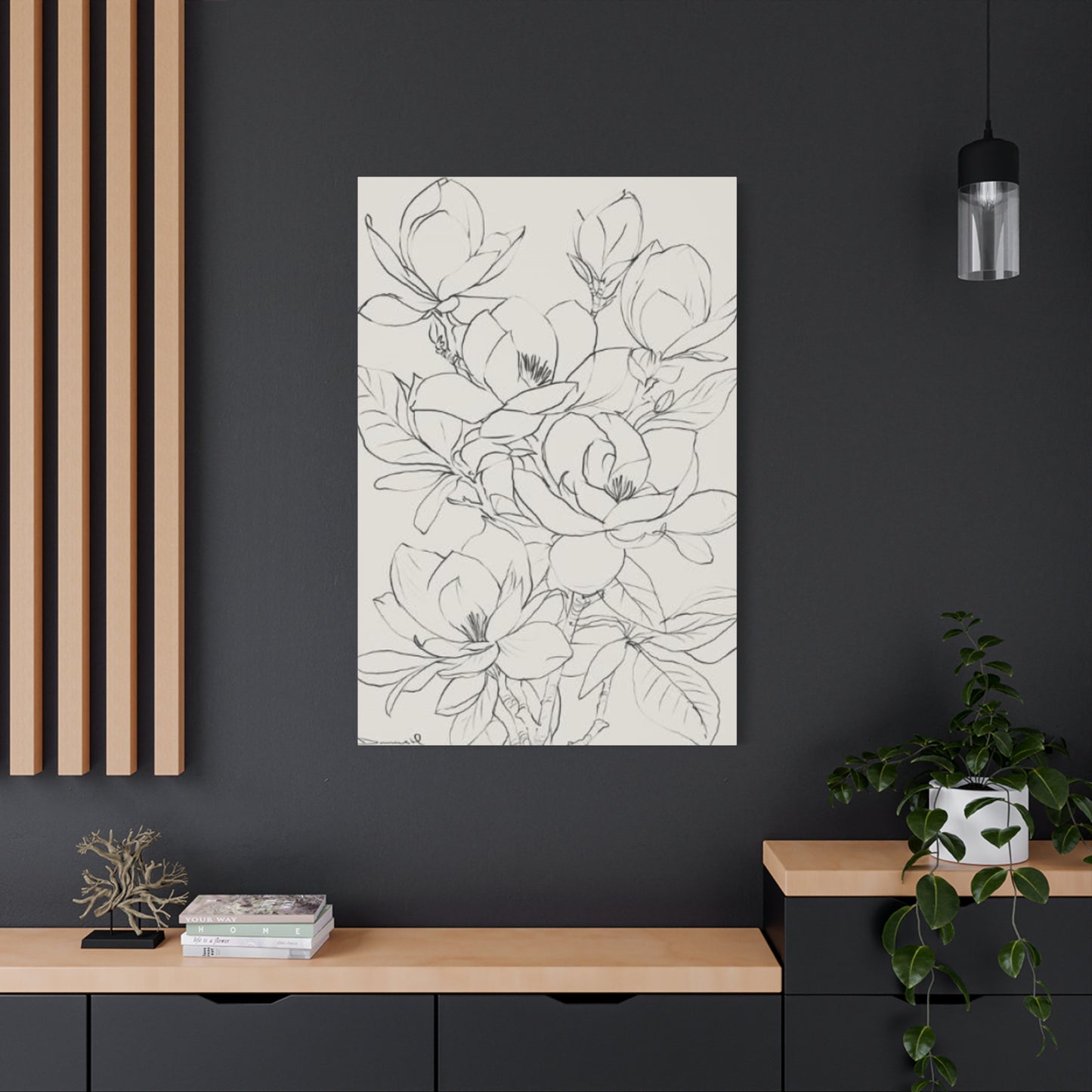Magnolia Flower Sketch Wall Art: Bringing Natural Elegance Into Your Living Spaces
Magnolia flower sketch wall art represents a sophisticated approach to interior decoration that combines botanical beauty with artistic expression. These delicate floral illustrations have become increasingly popular among homeowners, designers, and art enthusiasts who seek to create serene, elegant living environments. The magnolia, with its distinctive petals and graceful form, serves as an ideal subject for sketched artwork that can elevate any room's aesthetic appeal.
The appeal of magnolia flower sketches lies in their ability to bridge traditional botanical illustration with contemporary minimalist design. These artworks capture the essence of nature in its purest form, using simple lines and subtle shading to convey the magnolia's inherent beauty. Whether rendered in pencil, charcoal, ink, or digital media, magnolia sketches offer a versatile decorative solution that complements various interior design styles from modern minimalist to classic traditional settings.
When incorporated into home decor, magnolia flower sketch wall art creates focal points that draw the eye while maintaining a sense of tranquility and sophistication. The organic curves and natural forms of magnolia blooms provide visual interest without overwhelming a space, making them particularly suitable for bedrooms, living rooms, dining areas, and professional office environments. The monochromatic or limited color palettes typically used in sketch art allow these pieces to integrate seamlessly with existing decor schemes while adding depth and character to walls.
Historical Significance of Magnolia Flowers in Artistic Representation
Magnolia flowers have held cultural and artistic significance across multiple civilizations for centuries. In ancient Chinese culture, magnolias symbolized purity, nobility, and feminine beauty, frequently appearing in traditional paintings and poetry. Artists throughout the Ming and Qing dynasties captured magnolia blooms in intricate detail, establishing a rich tradition of magnolia representation that continues to influence contemporary botanical art.
The magnolia genus, named after French botanist Pierre Magnol, became a subject of scientific illustration during the Age of Exploration when botanical artists documented newly discovered plant species. These early botanical drawings combined scientific accuracy with artistic sensibility, creating detailed renderings that served both educational and aesthetic purposes. The tradition of botanical illustration established techniques and approaches that modern sketch artists continue to employ when creating magnolia flower artwork.
In Western art history, magnolias gained prominence during the Victorian era when botanical studies and nature appreciation reached new heights of popularity. Artists working in various media explored the magnolia's unique structure, from its large, showy petals to its distinctive cone-like seed pods. The flower's exotic origins and striking appearance made it a favorite subject for still life paintings, watercolors, and sketch studies that adorned the walls of educated households.
The symbolism associated with magnolias has evolved across different cultures, but common themes include perseverance, dignity, and love of nature. In the American South, magnolias became emblematic of Southern hospitality and grace, frequently appearing in regional art and design. This rich cultural heritage adds layers of meaning to contemporary magnolia flower sketch wall art, allowing viewers to connect with traditions that span centuries and continents.
Artistic Techniques Used in Creating Magnolia Flower Sketches
Creating compelling magnolia flower sketch wall art requires mastery of various artistic techniques that bring botanical subjects to life on paper or canvas. Line work forms the foundation of effective sketch art, with artists using varied line weights to suggest depth, texture, and form. Delicate, flowing lines capture the smooth curves of magnolia petals, while heavier, darker lines can define edges and create shadows that give dimensionality to the illustration.
Shading techniques play a crucial role in transforming flat outlines into three-dimensional representations of magnolia flowers. Artists employ cross-hatching, stippling, and graduated tonal work to suggest the play of light across petal surfaces. The subtle transitions from light to shadow help viewers perceive the fleshy thickness of magnolia petals and the way they curl and fold in nature. Skilled artists pay particular attention to the light source in their compositions, ensuring that shadows and highlights remain consistent throughout the piece.
Negative space utilization is another important aspect of magnolia flower sketch creation. By carefully considering the areas left blank or lightly marked, artists can enhance the impact of their line work and create breathing room within the composition. The strategic use of white space allows the magnolia blooms to stand out prominently while preventing the artwork from feeling cluttered or overwhelming. This approach aligns particularly well with minimalist design principles that value simplicity and intentional composition.
Texture rendering distinguishes exceptional magnolia sketches from mediocre ones. Artists must convey not only the smooth, waxy surface of magnolia petals but also the rougher texture of stems, the delicate nature of stamens, and the varied surfaces of leaves. Different mark-making techniques, from smooth, continuous strokes to short, varied marks, help communicate these textural differences. Some artists incorporate mixed media elements, combining traditional sketching with subtle watercolor washes or colored pencil accents to add depth and visual interest.
Compositional choices significantly impact the effectiveness of magnolia flower sketch wall art. Artists must decide whether to focus on a single bloom in detail, create arrangements of multiple flowers, or incorporate other botanical elements like buds, leaves, and branches. The placement of elements within the picture plane, the use of overlapping forms, and the balance between detailed and simplified areas all contribute to creating visually compelling artwork that holds viewer attention.
Different Styles of Magnolia Flower Sketch Wall Art
Botanical illustration style represents one of the most traditional approaches to magnolia flower sketch art. This style prioritizes scientific accuracy and detailed observation, presenting magnolias with precise rendering of every petal, stamen, and leaf vein. Botanical illustration sketches often include multiple views of the same flower, showing front, side, and back perspectives, along with cross-sections and detail studies of reproductive structures. This approach appeals to nature enthusiasts and those who appreciate the intersection of art and science.
Minimalist magnolia sketches embrace simplicity and restraint, using the minimum number of lines necessary to suggest the flower's form and character. This contemporary style strips away extraneous details, focusing on the essential gesture and movement of the magnolia bloom. Single-line drawings, where the artist creates the entire image without lifting pen from paper, represent an extreme expression of minimalist magnolia art. These spare, elegant compositions work particularly well in modern, uncluttered interiors where visual simplicity is valued.
Realistic sketch style aims to capture magnolias as they appear in nature, with careful attention to proportion, perspective, and tonal values. Artists working in this style spend considerable time studying live magnolia flowers or high-quality photographic references to ensure accuracy in their renderings. The resulting artworks display sophisticated understanding of form, light, and shadow, creating convincing illusions of three-dimensional flowers on two-dimensional surfaces. Realistic magnolia sketches suit traditional and transitional interior design schemes where classical artistic values are appreciated.
Abstract interpretations of magnolia flowers push beyond literal representation to explore emotional and aesthetic qualities through simplified forms, exaggerated proportions, or non-naturalistic arrangements. Abstract magnolia sketches might focus on the rhythmic curves of petals, the negative spaces between forms, or the overall gesture of a blooming branch rather than botanical accuracy. This style offers greater creative freedom and can result in bold, dynamic artwork that makes strong visual statements in contemporary living spaces.
Vintage botanical style mimics the appearance of historical natural history illustrations, often incorporating aged paper effects, sepia tones, or antique scientific notation. These magnolia sketches evoke nostalgia and scholarly tradition, appealing to collectors of antique aesthetics and those who appreciate the history of botanical science. Vintage-style magnolia art pairs beautifully with traditional decor, library settings, and spaces that celebrate intellectual pursuits and natural history.
Color Palettes and Their Impact on Magnolia Sketch Artwork
Monochromatic color schemes remain the most classic choice for magnolia flower sketch wall art, utilizing various shades of a single color to create depth and interest. Black and white compositions offer maximum versatility, complementing virtually any interior color scheme while maintaining a timeless, sophisticated appearance. Grayscale magnolia sketches allow artists to focus on form, value, and composition without the complexity of color relationships, resulting in elegant, understated artwork that never feels dated.
Sepia and warm earth tone palettes give magnolia sketches a vintage, nostalgic quality that works beautifully in traditional and rustic interiors. Browns, tans, and warm grays create a sense of age and scholarly refinement, suggesting antique botanical plates or historical nature studies. These warm neutral tones add coziness to spaces while maintaining the sophisticated character that magnolia artwork naturally conveys. Sepia-toned sketches often feature deliberately aged or textured backgrounds that enhance the vintage aesthetic.
Cool neutral palettes incorporating soft grays, slate blues, and charcoal tones provide a contemporary alternative to traditional black and white. These cooler color schemes create a sense of calm and serenity, making them ideal for bedrooms, meditation spaces, and modern minimalist interiors. Cool-toned magnolia sketches can feel particularly refreshing in spaces dominated by warm wood tones or beige color schemes, providing visual balance and a breath of fresh air.
Limited color accent approaches introduce subtle touches of color to primarily monochromatic magnolia sketches. A hint of pink in the petal centers, a touch of green in the leaves, or a soft yellow in the stamens can add just enough color to create visual interest without overwhelming the sketch aesthetic. These restrained color applications maintain the refined character of sketch art while acknowledging the natural colors of magnolia flowers, creating a bridge between pure line drawing and fully rendered botanical painting.
Duotone color schemes use two contrasting or complementary colors to create striking magnolia sketch artwork. Navy blue and gold, forest green and cream, or burgundy and gray pairings can produce sophisticated, design-forward pieces that make bold statements while maintaining the essential character of sketch art. Duotone approaches work particularly well in contemporary and eclectic interiors where unexpected color combinations add personality and visual excitement to spaces.
Selecting the Perfect Magnolia Sketch for Your Space
Room size and wall dimensions play a crucial role in determining appropriate magnolia flower sketch sizes and orientations. Large, open walls in spacious rooms can accommodate oversized statement pieces or gallery arrangements featuring multiple magnolia sketches. Smaller spaces benefit from more modestly sized artworks that provide visual interest without overwhelming limited wall areas. Vertical or horizontal orientation should complement the proportions of both the wall space and the overall room dimensions to create balanced, harmonious displays.
Existing decor style significantly influences which type of magnolia sketch will integrate most successfully into a space. Traditional interiors with classic furniture and rich wood tones pair beautifully with detailed botanical illustration styles or vintage-inspired magnolia sketches. Contemporary spaces featuring clean lines, neutral palettes, and minimalist furnishings call for simplified, modern interpretations with spare line work and ample negative space. Transitional interiors that blend traditional and contemporary elements offer flexibility, accommodating a range of magnolia sketch styles from moderately detailed botanical studies to slightly simplified artistic interpretations.
Color scheme compatibility ensures that magnolia flower sketch wall art enhances rather than clashes with existing room colors. Neutral interiors dominated by whites, grays, and beiges provide blank canvases that welcome virtually any style of magnolia sketch. Rooms with established color schemes require more careful consideration, whether selecting artworks that harmonize with existing hues or choosing pieces that provide deliberate contrast to create visual interest. The frame color and matting choices also impact how well artwork integrates with surrounding decor.
Lighting conditions in the intended display location affect both the visibility and impact of magnolia sketch artwork. Spaces with abundant natural light can support more subtle, delicately rendered sketches with fine details and low-contrast compositions. Rooms with limited or artificial lighting benefit from bolder magnolia sketches with stronger line work and greater tonal contrast that remain visible and impactful in lower light conditions. The placement of artwork relative to windows, lamps, and overhead fixtures should be considered to avoid glare and ensure optimal viewing conditions.
Personal taste and emotional response ultimately determine which magnolia flower sketch will bring the greatest satisfaction and enjoyment. Beyond matching decor styles and color schemes, artwork should resonate on a personal level, evoking positive emotions and creating a sense of connection with the subject matter. Taking time to live with potential art selections, even digitally placing them in photos of your space, can help ensure choices that will remain pleasing for years to come.
Framing and Presentation Options for Magnolia Flower Sketches
Frame style selection dramatically influences the overall appearance and impact of magnolia flower sketch wall art. Traditional wood frames in rich finishes like walnut, mahogany, or cherry provide classic elegance that suits formal spaces and vintage-style sketches. Simple, natural wood frames in lighter tones like oak, maple, or birch offer versatile options that work across multiple design styles from farmhouse to Scandinavian modern. The grain pattern and finish of wood frames add texture and warmth that can enhance the organic nature of botanical subjects.
Metal frames present contemporary alternatives that work particularly well with minimalist and modern interpretations of magnolia sketches. Thin black metal frames create crisp, clean presentations that emphasize the artwork itself without distraction. Gold, brass, and copper metal frames add luxury and visual warmth while maintaining sleek profiles suitable for contemporary spaces. Silver and chrome frames offer cool, sophisticated options for ultra-modern interiors where metallics play prominent roles in the design scheme.
Matting choices provide important breathing room between artwork and frame while offering opportunities to enhance the presentation. White and off-white mats create clean, gallery-quality presentations that work across all styles and color schemes. Colored mats can be used to pick up subtle tones within the artwork or to create deliberate color relationships with surrounding decor. Double matting, with an inner mat in a contrasting color, adds depth and sophistication to the presentation. Mat width should be proportional to both the artwork size and the frame dimensions to maintain visual balance.
Floating frame presentations create contemporary displays where artwork appears to hover within the frame, separated from the backing by a small gap. This mounting technique works exceptionally well with magnolia sketches on canvas or thick paper stock, adding dimensional interest and a gallery-quality appearance. The shadow created by the floating effect adds subtle depth that enhances the visual impact of the artwork without overwhelming the delicate nature of sketch art.
Frameless mounting options offer minimalist alternatives that emphasize the artwork itself. Museum-quality acrylic mounting sandwiches magnolia sketches between clear acrylic panels, creating a clean, modern presentation that seems to float on the wall. This approach works particularly well with contemporary interiors and with sketch art that features significant white space. Canvas-mounted sketches stretched over wooden frames can be displayed without additional framing, though this approach works better with sturdier sketch media than with delicate pencil or charcoal drawings.
Creating Gallery Wall Arrangements with Magnolia Sketches
Symmetrical gallery arrangements create formal, balanced displays that work beautifully in traditional and transitional interiors. Grid layouts with evenly spaced magnolia sketches of identical or similar sizes produce orderly, cohesive presentations that feel intentional and carefully curated. Symmetrical arrangements might feature multiple studies of the same magnolia from different angles, a series showing magnolia blooms in various stages of opening, or a collection of different magnolia species presented in matching frames. This approach creates visual calm and works particularly well in formal dining rooms, traditional living rooms, and professional office spaces.
Asymmetrical gallery walls offer more dynamic, contemporary alternatives that can accommodate magnolia sketches in varying sizes, orientations, and frame styles. These arrangements require careful planning to achieve visual balance without strict symmetry, considering the visual weight of individual pieces and how they relate across the overall composition. Asymmetrical displays can feel more casual and collected-over-time, adding personality and visual interest to contemporary, eclectic, and transitional spaces. The key to successful asymmetrical arrangements lies in creating balance through thoughtful placement rather than mirror-image repetition.
Salon-style hanging maximizes wall coverage with magnolia sketches and complementary artwork covering most of the available space from near ceiling height to just above furniture level. This approach, popular in European homes and galleries, creates immersive visual experiences and allows for extensive collections to be displayed together. Salon walls can incorporate magnolia sketches in various sizes and styles, unified by consistent framing or a cohesive color palette. This dense hanging style works best on large walls in spacious rooms where the full impact can be appreciated from a distance.
Linear arrangements place magnolia sketches in horizontal or vertical rows, creating streamlined presentations suitable for hallways, above sofas, or along stairwells. Horizontal linear arrangements work particularly well for series of similar-sized sketches depicting different magnolia varieties or showing botanical progression from bud to full bloom. Vertical arrangements draw the eye upward, making rooms feel taller while making efficient use of narrow wall spaces. Linear displays offer structured, uncluttered alternatives to more complex gallery arrangements while still allowing multiple pieces to be displayed together.
Mixed media gallery walls combine magnolia flower sketch wall art with other types of artwork, photographs, mirrors, and decorative objects to create eclectic, personalized displays. This approach allows magnolia sketches to serve as anchors within larger compositions that reflect diverse interests and experiences. Mixed media walls work particularly well in casual, family-oriented spaces where personal expression takes precedence over formal design rules. The key to successful mixed media arrangements lies in finding unifying elements, whether consistent framing, a cohesive color palette, or thematic connections between disparate pieces.
DIY Approaches to Creating Your Own Magnolia Flower Sketches
Observational drawing from live magnolia flowers provides the most authentic foundation for creating original sketch artwork. Obtaining fresh magnolia blooms from gardens, florists, or natural settings allows artists to study the flowers from multiple angles, observing how light interacts with petal surfaces and how forms overlap and recede in space. Setting up a simple still life arrangement with natural lighting enables careful observation of the subtle color variations, surface textures, and structural details that make magnolia flowers distinctive. This hands-on approach develops observational skills and creates opportunities for unique, personal interpretations.
Working from photographic references offers practical alternatives when live flowers are unavailable or when capturing specific perspectives or lighting conditions. High-resolution photographs of magnolias provide detailed information about form, structure, and tonal relationships that can be referenced repeatedly throughout the drawing process. Multiple reference photos showing the same flower from different angles help artists understand the three-dimensional structure they are attempting to represent on flat surfaces. Combining information from several references can result in composite sketches that represent idealized magnolia forms rather than exact reproductions of single specimens.
Basic materials for magnolia flower sketching include quality drawing paper with appropriate tooth for the chosen medium, graphite pencils in various hardnesses for creating different line qualities and tonal values, and erasers for correcting mistakes and lifting highlights. Smooth paper works well for detailed, precise line work, while textured paper can add interesting surface qualities to sketch art. Pencil sets ranging from hard leads for light, precise lines to soft leads for rich, dark shadows provide flexibility in mark-making. Kneaded erasers allow for subtle tonal adjustments, while precision erasers enable fine detail work.
Developing fundamental drawing skills enhances the quality of DIY magnolia sketches. Understanding basic perspective principles helps create believable spatial relationships between overlapping petals and surrounding botanical elements. Proportion observation ensures that various parts of the magnolia flower relate correctly to one another in size and scale. Value assessment skills enable artists to accurately perceive and reproduce the range of lights and darks that give form and dimension to sketched flowers. Regular practice sketching simple objects builds hand-eye coordination and mark-making confidence that translates to more complex botanical subjects.
Composition planning transforms individual flower studies into wall-worthy artwork. Decisions about whether to create a single centered bloom, an off-center composition with asymmetrical balance, or an arrangement of multiple flowers significantly impact the final aesthetic. Consideration of negative space, the edges of the picture plane, and the visual flow within the composition all contribute to creating engaging artwork rather than mere botanical documentation. Thumbnail sketches exploring different compositional approaches before committing to final artwork can save time and improve results.
Digital Methods for Creating Magnolia Sketch Wall Art
Digital drawing tablets and styluses enable artists to create magnolia flower sketches with natural, hand-drawn qualities while enjoying the flexibility and convenience of digital media. Pressure-sensitive styluses respond to varying hand pressure, creating line variation and tonal gradation similar to traditional pencils and pens. Digital drawing allows for unlimited experimentation without wasting materials, easy correction of mistakes, and the ability to work in layers that can be adjusted independently. Once completed, digital sketches can be printed at various sizes and on different substrates to suit specific display needs.
Vector-based illustration software offers distinct advantages for creating magnolia sketches intended for reproduction at multiple sizes. Vector graphics use mathematical curves rather than pixels, allowing artwork to be scaled infinitely without quality loss. This makes vector illustrations ideal for projects requiring flexibility in sizing, from small accent pieces to oversized statement artwork. The clean, precise lines characteristic of vector art work particularly well for minimalist and modern interpretations of magnolia flowers, though skilled artists can achieve surprising warmth and organic qualities within vector format.
Raster-based digital painting programs provide tools that closely mimic traditional art materials, including pencils, charcoal, ink, and watercolor. These programs allow artists to create magnolia sketches with rich, varied textures and subtle tonal transitions that can rival or exceed what is possible with physical media. Custom brush creation enables development of unique mark-making tools tailored to individual artistic approaches. Layer blending modes and adjustment capabilities provide extensive post-creation refinement options that can enhance and polish finished artwork.
Photography-based digital art combines photographic source material with digital manipulation to create sketch-like artwork. Filters and effects can transform magnolia flower photographs into images that resemble hand-drawn sketches, offering quick results for those without traditional drawing skills. More sophisticated approaches involve tracing photographic outlines and selectively applying sketch effects to create hybrid images that retain photographic detail in some areas while exhibiting drawn qualities in others. These techniques can produce interesting results, though they generally lack the authentic character of genuinely hand-drawn artwork.
Online design tools and templates provide accessible entry points for creating magnolia sketch wall art without extensive artistic training. Web-based platforms offer libraries of botanical illustrations and sketch elements that can be arranged and customized to create personalized compositions. While these tools may not satisfy those seeking to create entirely original artwork, they offer practical solutions for quickly generating decent quality magnolia designs for personal use. Understanding the licensing terms associated with these tools ensures proper usage rights for any artwork created.
Printing and Reproduction Considerations for Magnolia Sketches
Print quality standards vary significantly based on the intended viewing distance and size of the final artwork. High-resolution printing at 300 dots per inch or greater ensures that fine details and subtle tonal transitions in magnolia sketches reproduce faithfully, creating professional-quality results suitable for close viewing. Lower resolution may suffice for oversized pieces intended for viewing from across a room, though most serious art reproduction maintains high standards regardless of size. File preparation should account for the specific resolution requirements of the chosen printing method and final size.
Printing substrate choices dramatically impact the appearance and longevity of reproduced magnolia sketch wall art. Fine art papers with cotton or alpha cellulose content provide archival quality and subtle texture that enhances the hand-drawn character of sketch art. Matte, satin, and glossy finishes each create different visual effects, with matte papers generally working best for pencil and charcoal sketch aesthetics. Canvas prints offer texture and contemporary gallery appeal, while metal and acrylic prints create modern, high-impact presentations that work well in certain design contexts. Sample printing on multiple substrates helps determine which option best serves specific artistic goals.
Color management ensures that printed magnolia sketches accurately represent the artist's intentions and maintain consistency across multiple reproductions. Calibrated monitors display colors accurately during the design process, while ICC color profiles help translation between screen display and printed output. Even monochromatic sketches benefit from careful color management to ensure that neutral grays remain truly neutral without unwanted color casts. Working with professional print services that understand color management eliminates much of the technical complexity while ensuring reliable results.
Archival considerations protect long-term investment in magnolia flower sketch wall art. Pigment-based inks offer superior lightfastness compared to dye-based inks, resisting fading when exposed to light over many years. Acid-free papers and proper matting materials prevent yellowing and deterioration over time. UV-protective glazing in frames provides additional defense against light damage. For truly archival presentations, following museum-quality standards in materials and methods ensures that artwork remains vibrant and intact for generations.
Limited edition printing adds collectibility and value to magnolia sketch artwork. Numbering and signing individual prints within small edition runs creates scarcity that can increase perceived and actual value. Artists should maintain careful records of edition numbers and destroy printing plates or digital files after edition completion to maintain the integrity of the limited series. Certificates of authenticity documenting the edition details, paper specifications, and printing method add professional polish and provide buyers with confidence in their purchases.
Magnolia Sketches in Children's Spaces and Educational Settings
Age-appropriate interpretations of magnolia subjects make botanical artwork accessible and engaging for younger viewers. Simplified sketches emphasizing bold shapes and clear forms work better for children's spaces than highly detailed botanical illustrations requiring mature visual literacy. Brighter colors and playful compositions can make magnolia artwork more appealing to children while maintaining botanical integrity. Educational labels or interactive elements transform decorative artwork into learning opportunities that support childhood development.
Developmental benefits of exposing children to nature imagery include improved concentration, reduced anxiety, and enhanced creative thinking. Magnolia flower sketch wall art in bedrooms, playrooms, and study areas provides consistent exposure to natural forms and organic patterns. Research suggests that even indirect nature experiences through imagery produce measurable psychological benefits for children. Creating visually rich environments that include botanical artwork supports healthy development and may foster lifelong appreciation for nature.
Classroom applications of magnolia sketches support various educational objectives across grade levels. Science teachers use botanical artwork to introduce plant biology concepts, discuss scientific illustration, and inspire nature observation. Art instructors employ magnolia sketches as examples when teaching drawing techniques, composition principles, or art history. Elementary classrooms might display simplified magnolia artwork as part of seasonal decorations or thematic units about spring, gardens, or trees.
Student-created magnolia artwork displayed alongside professional pieces validates young artists' efforts and creates personally meaningful learning environments. Classroom projects sketching magnolias from observation or photographs teach both artistic and scientific skills while producing display-worthy results. Gallery-style presentations of student work in hallways and common areas demonstrate institutional commitment to arts education and create pride in student accomplishments. These displays can inspire younger students while providing older students with authentic audiences for their creative work.
Library and media center displays of magnolia sketches and other botanical artwork create welcoming, intellectually stimulating atmospheres that encourage reading and learning. Thematic displays might coordinate magnolia artwork with book collections about nature, gardening, or scientific discovery. Rotating displays prevent visual stagnation and create opportunities to showcase diverse artistic styles and botanical subjects throughout the year. These thoughtful environmental design choices communicate that libraries value beauty alongside information resources.
The Role of Social Media in Magnolia Art Discovery and Sharing
Visual platforms like Instagram and Pinterest serve as primary discovery channels for contemporary magnolia flower sketch wall art. Artists use these platforms to build followings, showcase portfolios, and sell work directly to appreciative audiences. Hashtags enable art seekers to find magnolia sketches among millions of images, connecting them with artists whose styles align with their preferences. The visual nature of these platforms perfectly suits botanical artwork, allowing immediate assessment of artistic quality and stylistic fit.
Community building around botanical art interests occurs through social media groups, online forums, and virtual galleries. Enthusiasts share discoveries, discuss techniques, and support artists through these digital communities. These connections transcend geographic limitations, creating global networks of people passionate about magnolia artwork and botanical illustration. Online communities provide education, inspiration, and purchasing guidance that enhance appreciation and collecting efforts.
Trending styles and viral artwork influence broader awareness and appreciation of magnolia sketches. When particular artistic approaches or individual pieces gain widespread attention through social sharing, they shape popular taste and market demand. Artists who successfully harness social media can achieve recognition and commercial success previously requiring gallery representation or traditional marketing. This democratization of art world access benefits both creators and consumers of magnolia sketch artwork.
Behind-the-scenes content showing creative processes demystifies artistic practice and builds connections between artists and audiences. Time-lapse videos of magnolia sketches emerging from blank pages, tool and material recommendations, and technique explanations provide valuable educational content while building artist brands. This transparency creates appreciation for the skill and effort required to produce quality botanical artwork, potentially justifying premium pricing for original and limited edition pieces.
Direct sales and commission opportunities through social media platforms enable artists to maintain larger shares of revenue compared to traditional gallery representation. Many botanical artists successfully build sustainable careers through direct-to-consumer sales facilitated by social media presence. Buyers benefit from lower prices compared to gallery-marked-up artwork while feeling good about supporting artists directly. This evolution in art commerce creates new possibilities for both emerging and established creators of magnolia sketch wall art.
Conservation and Archival Considerations for Original Magnolia Sketches
Paper quality fundamentally impacts the longevity of original magnolia sketches. Acid-free papers made from cotton rag or alpha cellulose resist yellowing and deterioration over centuries when properly cared for. Wood pulp papers containing lignin gradually acidify and become brittle, unsuitable for artwork intended to last. Archival quality designation ensures that paper meets established standards for permanence and stability. Serious collectors and artists prioritize acid-free materials for work intended to endure.
Media permanence varies significantly among drawing materials used for magnolia sketches. Graphite pencil generally offers excellent lightfastness and stability when properly applied to quality paper. Charcoal requires fixative to prevent smudging and can fade or deteriorate without proper protection. Ink permanence depends on formulation, with pigment-based archival inks vastly outperforming dye-based alternatives. Artists creating work for sale or collection should use materials rated for permanence and document media specifications for buyers.
Storage conditions for unframed or temporarily stored magnolia sketches require attention to prevent damage. Flat storage in acid-free folders and boxes prevents creasing, folding, and pressure damage. Interleaving tissues between stacked pieces prevent offset transfer and surface abrasion. Climate-controlled storage areas with stable moderate temperature and humidity protect against mold, insect damage, and material degradation. Original artwork represents significant investment that justifies proper storage infrastructure.
Professional conservation services provide expert assessment and treatment when valuable magnolia sketches show signs of deterioration or damage. Conservators can address issues like acid migration from poor quality mats, mold remediation, tear repair, and backing removal. Conservation-quality reframing replaces substandard materials with museum-quality alternatives that protect rather than damage artwork. Consulting professional conservators before attempting repairs prevents well-intentioned but potentially harmful interventions.
Documentation and provenance records establish the history and authenticity of magnolia sketch artwork. Detailed records including artist information, creation dates, media specifications, exhibition history, and ownership chain add value and facilitate future conservation, insurance, and sale. Photographs documenting condition at various points in time provide evidence of proper care or alert to developing problems. This paper trail transforms individual artworks into documented cultural objects with verifiable histories.
Magnolia Flower Sketches in Different Cultural Contexts
Japanese artistic traditions incorporate magnolia imagery differently than Western botanical illustration approaches. The aesthetic principles of wabi-sabi, emphasizing beauty in imperfection and impermanence, might influence how Japanese artists render magnolia subjects. Ink painting techniques using varying ink densities and expressive brushwork create magnolia sketches with different qualities than Western pencil or charcoal drawings. Understanding these cultural differences enriches appreciation for diverse approaches to the same botanical subject.
Chinese painting traditions include magnolias among the flowers used in brush painting practice and masterworks. The "four gentlemen" traditionally include bamboo, orchid, plum blossom, and chrysanthemum, but magnolias also appear in classical Chinese flower painting. The emphasis on capturing the spirit or essence of subjects rather than photographic accuracy produces magnolia sketches quite different from Western botanical illustration. Calligraphic brushwork and composition principles reflecting Chinese aesthetic philosophy create distinctive artistic statements.
European botanical illustration history influences contemporary magnolia sketch aesthetics through centuries of scientific documentation. The detailed, precise rendering style developed for botanical texts and natural history publications established conventions still followed today. European tradition emphasized accuracy, multiple views, and careful rendering of botanical details for identification purposes. Contemporary artists working in this tradition create magnolia sketches that connect to this scholarly heritage while serving modern decorative purposes.
American interpretations of magnolia subjects often reflect regional cultural associations, particularly in the Southern United States. The magnolia's iconic status in Southern culture can influence how artists approach the subject, potentially emphasizing grandeur, elegance, and symbolic resonances with regional identity. Contemporary American botanical artists work in diverse styles from scientifically precise illustration to expressive artistic interpretation, reflecting American cultural diversity and artistic freedom.
Contemporary global fusion approaches blend techniques, aesthetics, and cultural perspectives from multiple traditions. Artists educated in or exposed to diverse cultural approaches can synthesize elements into unique personal styles. Magnolia sketches might combine Western observational accuracy with Eastern compositional principles and contemporary design sensibilities. This cultural cross-pollination produces fresh, innovative botanical artwork reflecting increasingly interconnected global artistic communities.
Therapeutic Applications of Creating Magnolia Sketches
Art therapy practices employ botanical sketching including magnolia subjects as tools for emotional expression and healing. The focused attention required for observational drawing can reduce anxiety and create mindful states similar to meditation. Processing difficult emotions through creative expression provides nonverbal outlets particularly valuable when words prove inadequate. The nature subject matter adds additional therapeutic value through connections with the natural world and its restorative qualities.
Mindfulness and meditation connections arise naturally during the process of creating magnolia sketches. The present-moment awareness required to observe and render botanical subjects quiets mental chatter and creates meditative flow states. Focusing on visual details like petal curves, tonal gradations, and structural relationships keeps attention anchored in immediate experience rather than past or future concerns. Regular sketching practice can develop sustained attention capacity that transfers to other life areas.
Motor skill development and maintenance benefit from the fine motor control required for detailed botanical sketching. Creating magnolia flower sketch wall art exercises hand-eye coordination and precise manual dexterity. For older adults, maintaining these skills through creative activities may help preserve independence and cognitive function. For individuals recovering from injuries affecting fine motor control, graduated sketching exercises can support rehabilitation while producing aesthetically pleasing results that build confidence.
Cognitive benefits of creative practice include improved problem-solving abilities, enhanced visual-spatial reasoning, and increased cognitive flexibility. The complex decisions involved in composing and rendering magnolia sketches exercise executive function and creative thinking. Learning new techniques and artistic approaches creates neuroplasticity that supports healthy brain aging. The sense of accomplishment from completing artwork provides psychological rewards that reinforce continued engagement with beneficial activities.
Social connection opportunities arise through group sketching activities, classes, and online communities centered on botanical art. Shared creative experiences build relationships and provide social support that contributes to wellbeing. Displaying personally created magnolia sketches creates conversation starters and opportunities to share interests with visitors. Participating in botanical art communities provides sense of belonging and shared purpose that combats isolation and loneliness.
Advanced Techniques for Experienced Botanical Artists
Mixed media approaches combine multiple materials to create complex, layered magnolia sketch artwork. Graphite underdrawings might be enhanced with watercolor washes, colored pencil accents, or ink details to create hybrid pieces that transcend single-medium limitations. Understanding how different media interact and planning layering sequences prevents technical problems like muddy colors or damaged surfaces. Mixed media work requires expanded material knowledge and technical facility but offers rich creative possibilities.
Experimental mark-making expands the visual vocabulary available for rendering magnolia subjects. Developing personal libraries of marks for suggesting various textures, values, and surfaces enables more expressive, distinctive artistic statements. Unconventional tools like sticks, cotton swabs, or fingers can create unique marks impossible with standard pencils and pens. Experimentation balanced with technical control produces artwork that displays both craftsmanship and creative innovation.
Unusual perspectives and viewpoints provide fresh approaches to frequently depicted magnolia subjects. Extreme close-ups focusing on magnolia stamen details, unusual angles viewing flowers from below or directly overhead, or abstract compositions emphasizing pattern and rhythm over botanical accuracy create striking alternatives to standard botanical portraits. These innovative perspectives demonstrate artistic vision and creative thinking while maintaining connections to recognizable subject matter.
Series development allows thorough exploration of magnolia themes through related but varied artworks. A series might investigate a single magnolia bloom throughout its lifecycle from tight bud to open flower to fading petals. Alternatively, series could explore different magnolia species, varied lighting conditions, or multiple artistic styles applied to similar subjects. Series development demonstrates sustained artistic inquiry and creates cohesive bodies of work suitable for exhibition or publication.
Portfolio refinement for exhibition or publication requires careful editing and presentation of strongest work. Selecting pieces that demonstrate technical excellence, artistic vision, and cohesive aesthetic direction creates professional portfolios that advance artistic careers. High-quality documentation of original sketches through photography or scanning ensures reproduction quality and enables digital portfolio sharing. Professional presentation distinguishes serious botanical artists from hobbyists, opening opportunities for gallery representation, commissions, and publication.
Conclusion:
Magnolia flower sketch wall art represents far more than simple decoration for empty walls. These elegant botanical illustrations connect us with the natural world, bringing organic beauty and tranquil sophistication into our daily living environments. Throughout this exploration, we have examined the multifaceted appeal of magnolia sketches from artistic, cultural, psychological, and practical perspectives, revealing layers of meaning and value that extend well beyond surface aesthetics.
The historical significance of magnolia representation in art spans centuries and crosses cultural boundaries. From ancient Chinese paintings celebrating nobility and purity to Victorian botanical studies documenting natural history, magnolias have captivated artists and viewers across time periods and geographic regions. This rich cultural heritage adds depth and resonance to contemporary magnolia sketch artwork, allowing modern viewers to participate in traditions that connect them with earlier generations who also found beauty and meaning in these remarkable flowers.
The artistic versatility of magnolia subjects enables expression across an enormous range of styles, from scientifically precise botanical illustration to minimalist contemporary interpretation. This flexibility ensures that magnolia flower sketch wall art can find appropriate homes in virtually any interior design context, whether traditional, modern, transitional, or eclectic. The monochromatic or limited color palettes typical of sketch art provide particular versatility, allowing these pieces to integrate seamlessly with existing decor while adding visual interest and sophistication to living spaces.
The psychological benefits of displaying nature-inspired artwork in our homes and workplaces have been well documented by researchers studying biophilic design and environmental psychology. Magnolia sketches provide daily contact with natural forms and organic beauty, reducing stress, improving mood, and supporting overall wellbeing. In increasingly urbanized environments where direct nature contact becomes more limited, bringing botanical imagery indoors serves important psychological needs that evolved over millennia of human development in natural settings.
The accessibility of magnolia flower sketch wall art makes it available to people at all budget levels and with varying artistic interests. Mass-produced prints provide affordable options for those furnishing first apartments or seeking temporary decorative solutions, while original artwork and limited edition prints serve serious collectors building valuable art collections. The option to create personal magnolia sketches adds another dimension of accessibility, allowing anyone with modest materials and willingness to learn to create meaningful artwork for their own spaces.
The educational value embedded in accurate botanical illustration serves purposes beyond pure decoration. Magnolia sketches can function as reference materials for plant identification, teaching tools for understanding botanical structures, and inspiration for deeper engagement with the natural world. This intellectual dimension adds substance to aesthetic appeal, making magnolia artwork particularly appropriate for libraries, studies, classrooms, and other spaces where learning and inquiry are valued.
The gift-giving applications of magnolia sketch artwork provide thoughtful options for marking significant life events and expressing care for others. The universal appeal of natural beauty combined with the specific symbolic associations of magnolia flowers creates gifts appropriate for diverse occasions from weddings to housewarmings to sympathy expressions. Personalized or commissioned pieces add extra meaning, transforming functional home decor into carriers of memory and relationship.
The creative possibilities offered by digital tools and technologies continue expanding what is possible in magnolia sketch creation and reproduction. Contemporary artists work with sophisticated digital illustration programs that produce results rivaling or exceeding traditional media in quality and expressive potential. Print-on-demand services and online marketplaces democratize access to botanical artwork while providing artists with direct paths to audiences without traditional gallery gatekeeping. These technological developments ensure continued evolution and innovation in botanical art practice.
The sustainability and conservation considerations surrounding magnolia artwork reflect growing environmental awareness and commitment to responsible consumption. Choosing archival materials, supporting artists who prioritize sustainable practices, and properly caring for artwork to ensure longevity all contribute to more environmentally conscious art collection. The nature-celebrating content of magnolia sketches aligns naturally with environmental values, creating philosophical consistency between artwork subjects and collection practices.

















